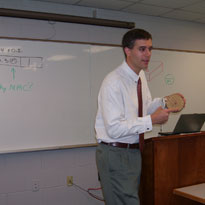Unleashing Engineering Creativity – Comprehensive
- Course:Unleashing Engineering Creativity – Comprehensive
- Course ID:ENG-CREATE3 Duration:3 days Where: Your Office (7+ Persons)
- Download Course Description (PDF)
Available as a private, customized course for your group at your offices or ours and in some cases as a WebLive(TM) class.
Course Outline
Day 1: Introductory Concepts and Creativity Enhancement Techniques
- Introduction and Course Overview. Defining creativity. Creativity Stages. Taylor’s hierarchy of creativity. Creativity obstacles, including fear of the unknown, fear of failure, reluctance to exert influence, frustration avoidance, resource myopia, participation reluctance, overcertainty, and structured thinking patterns.Why we lose most of our creativity before we finish high school, and what we can do to regain it. Group exercise.
- Brainstorming and Painstorming. Brainstorming approaches. Brainstorming rules. Identifying areas of customer dissatisfaction. Sources of customer product satisfaction information. Examples. Group exercise.
- Synectics. Disciplined idea harvesting. Documenting “I wish” comments. Including customer participation. Funneling ideas into manageable options. Examples. Group exercise.
- Functional Decomposition. Identifying functional requirements. Inputs and outputs. Flowcharting. Identify functional interactions and conflicts. Systems engineering and requirements allocation. Making trades. Examples. Group exercise
- Ethnography. Definitions and approach explanation. Gathering information by examining cultures. Understanding design impacts on individuals and cultures. Understanding the consumer experience. Examples. Group exercise.
- Biomimicry. Definitions. Seeking solutions by emulating nature. Finding appropriate emulation targets. Reducing cost and waste. Examples.
Group exercise.
Day 2: Advanced Approaches: QFD, Axiomatic Design, and TRIZ
- Quality Function Deployment. The house of quality. Identifying, requirements, needs and wants. Prerequisites. The what’s, the how’s, and the how much’es. The graphical approach. Quantifying engineering and client tradeoffs. Internal and external benchmarking assessments. Using Excel. Examples. Group exercise.
- Axiomatic Design. The independence and information axioms. Matrix methods. Maintaining design parameter independence. Transitioning from functional requirements to design parameters to process design with axiomatic design. Transforming customer needs into products and processes. Examples. Group Exercise.
- TRIZ. TRIZ background and development history. The theory of inventive problem solving. Using the TRIZ matrix and the 40 design solutions. Analogical thinking. Putting constraints to work. Using the conflict resolution matrix. Available software resources. Examples. Group exercise.
Day 3: More Creativity Stimulation Techniques and Workshop Wrap-up
- Lateral Benchmarking. Finding best practices. Looking outside your industry for best practices. Strategies for identifying lateral industries. Not knowing what can’t be done. Examples. Group exercise.
- Kano Model. Product development and customer satisfaction. The attractive, one-dimensional, must-be, indifferent, and reverse categories. Relationship to quality function deployment. Examples. Group exercise.
- Trimming. Identifying functions, developing approaches for alternative assignment, recipient functional assignment, function elimination, redesigning for improved functionality, and identifying new markets as a result of improved functionality. Examples. Group exercise.
- Nine Windows. The nine windows grid. Considering innovation from the perspectives of time (past, current, future) and space (super-system, system, sub-system). Examples. Group exercise.
- De Bono’s Six Hats. The Six Thinking Hats by Edward De Bono. Information, emotions, bad points judgment, good points judgment, creativity, and meta-thinking. Overcoming our natural tendencies toward black hat thinking. Examples. Group exercise.
- De Bono’s Concept Fans. Discovering alternative solutions. Graphical presentations. Taking steps back to gain a broader perspective. Similarities to mind mapping. Examples. Group exercise.
- Bisociation. Blending elements from two fields previously considered unrelated. The comparison, abstraction, categorization, analogies, and metaphors matrix. Concept blending theories. Examples. Group exercise.
- Course Wrap-Up. Course review. Questions and answers. Plans for future actions. Course critique.
Course in a Nutshell
An extended, 3-day version of our popular Unleashing Engineering Creativity course, this workshop explores the best techniques for stimulating thinking, creating new products or services, and solving design challenges. It offers a much more in-depth examination of all topics, particularly quality function deployment, TRIZ, and axiomatic design, compared with its two-day counterpart. Many organizations and engineers rely on brainstorming, but this simplistic approach often fails to stimulate creativity in a meaningful way. This course goes far beyond brainstorming. It explores state-of-the-art creativity stimulation approaches and provides recommendations for overcoming self-imposed obstacles. This is an intensely engaging workshop that will help your organization realize significant creativity improvements. It includes lectures, interactive discussion, examples, and group exercises to assure thorough comprehension and comfort levels with the exciting creativity enhancement approaches discussed here.
Customize It!
Whatever the nature of your systems, products/services, and objectives, we will customize the course to meet your specific needs and concerns. Here are some of the ways in which we can tailor the course to help you get more out of it:
- Additional “workshop days” to allow participants to work together to address creativity enhancement topics specific to your organization. The workshop day can be scheduled a few weeks after the course to allow time for applying the technologies presented in class under an experienced engineer.
- Schedule post-class follow-up consultation for continuing your in-house creativity stimulation implementation.
Learn How To
- Work together to understand and implement creativity stimulation concepts and techniques.
Aimed At
This workshop is aimed at engineers, designers, business strategists, business development specialists, and others charged with creating innovative products or services as well as others who work with them or manage their work.
Prerequisites
While there are no formal prerequisites, this workshop assumes a design, engineering development, or business development background.
- "Unlike the 'softer' creativity courses now on the market, we wanted a hard-hitting program developed and taught by and for engineers. Creativity is at the root of what we do. We were looking for a workshop that was state-of-the-art, aimed at technical folks, application oriented, and taught by an SME. This workshop will go a long way in helping us master the art and science of inventing." - Dorin Balcan, Director Engineering, Zebra Technologies
- “Wanted my team trained in the structured way about the act of inventing. Very comprehensive, a lot to choose from. Instructor very well informed, lots of experience, used examples very well. Keep doing what you’re doing. Overall a great class, I’d highly recommend it.” – Engineering Director, Fortune 500 Tech Organization

